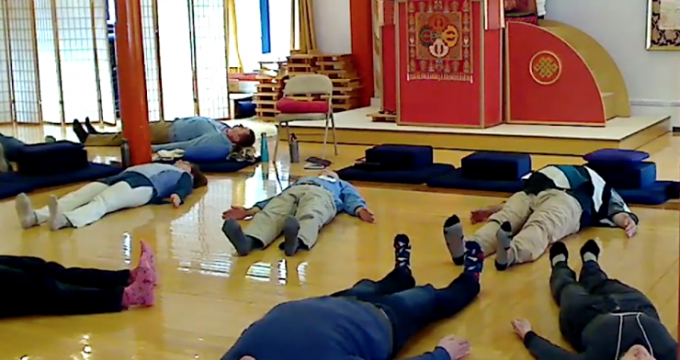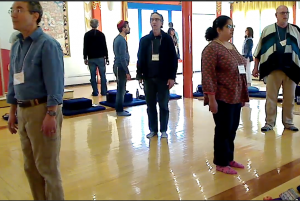Chaos and Vastness
Mudra’s connection to a sense of chaos is very interesting. A system is called chaotic if small changes in the initial conditions at some initial time lead to large differences at some later time. That seems to very much apply to a large view of reality that is very true—in a relative as well as an absolute way. (That’s why there is a so-called “Butterfly Effect” and why we engage in our dharmic practices that have the power to change our minds and the environment.)
The theory of chaos has a place in mathematical thought. Mathematics uses the symbols of numbers and equations to express a language for patterns—much like words and letters are used for stories, thoughts, concepts and ideas. In a certain way, the insights and actions of Mudra Space Awareness (“Mudraspeak” if you will) could be considered the language for total gesture to foment enlightened human activity. But—just like the formulae and fixed creations of mathematics can be used to convince, obscure, manipulate and misappropriate the truth—it seems the mechanics of Mudra could also be misapplied.
Chaos isn’t the same as randomness. In mathematics, randomness is a theoretical concept—a product of the human mind that can’t really be simulated because it relies on a finite quantity to stand in for Infinity. Humans cannot create randomness, but often call situations ‘chaotic’ when environments can’t be controlled or when patterns of an activity can’t be discerned. Usually, what they mean is that something is pointless, meaningless, patternless, and/or nihilistic—and that gets conflated with fear in the confusion that is often stirred up by chaos.
Mudra can provide us with confidence to see through confused experience and provide stability for our intelligence, which in turn can lead us to taste a sense of vastness beyond our normal sleepiness. This can come as a profound sense of auspicious coincidence that completely embraces limitless interdependence. That might look like ‘chaos’, but just because we—in our limited awareness—don’t see or understand some underlying pattern or unborn principle, that doesn’t mean that it isn’t there. Chaos is indeed good news—because it acknowledges that even small gestures can have huge effects.
With the application of great effort in intensification, Mudra helps to juxtapose the impossible with actual experience, so that our paltry efforts to stay in familiar territory and retain control are given up. Similar to a Zen koan, where all effort to make logical sense has to be let go, Mudra exercises use our entire body and sense faculties to lead us to a powerful non-conceptual imprint of non-duality.
Empirical ‘Evidence’ is Unique
Mudra Space Awareness is a vehicle for understanding dharmic reality and working with it. If we try to interpret the discipline too much, justify it too rigidly, and/or “connect too many dots”, the whole endeavor will fall apart. As the development and evolution of Mudra goes forward, we could pay attention to our own intelligence in its evolution, and be on the lookout for counterproductive consequences. When a too heavy-handed logic of philosophical theory is applied or enthusiasm causes us to move too fast (erroneously thinking we might need replicable lab evidence or even more speeding up to justify mudra practice) we should ask ourselves: How is that sensed in our hearts, how does it feel in our bodies, and what kind of conditions does it create in our minds? If panic ensues, we go numb, zone out, or it makes us feel sleepy–then we could commit to paying attention to those red flags, sharing our unique insights with each other, and working together to self-correct.
New Ways to Experience and to Know
A phenomenal explanation of Mudra practice might use some of the philosophical ideas of Ontology (how we experience, sense, and ‘be’ in the world) and Epistemology (how we know, including the ways that we gather knowledge)—but formal academics is more or less turned on its head in mudra activity. We should be careful when trying to use academics to explain or support Mudra practice too much. Profound groundlessness, that includes confounding of conventional logic and lack of rigid definitions, must be interwoven into Mudra’s very fabric. The nature of what it means to exist (or not)—altogether—and the unshakeable prajna of knowing doubtlessly without conventional logic must be at the core of Mudra. There should be total acceptance of the practice having its roots in ineffable non-duality that defy conventional explanation.
The urge to interpret Mudra too rigidly will not serve it. in developing outward-facing interpretations and representations of Mudra, we should protect it from becoming too ‘concrete sequential’ in explanation, as well as too un-nuanced, rigidified, or prescriptive.
Authentic Presence ~ To Sense, To Be, To Act Genuinely from a Place of Conviction
Mudra practice aims to give us glimpses of full-bodied experience that is not colored by our conventional or habitual biases. Practitioners know that it can open them into new insights regarding their own particular ego defense mechanisms. Mudra can give us vivid imprints and clues into the ways we prop ourselves up with subtle self-cherishing habits.
An unobscured view of bigger awareness could lead to further non-conceptual understanding in how to evoke genuine gestures in the world. These authentic gestures could be expressions of true wisdom: informed by each individual’s unique intelligence and synchronized with the drala in the environment.
As we move forward in a socially distanced world on the Internet, how do we convey our authentic presences to each other—fostering genuine deep connection to and appreciation for each other—without a relationship found in real-time-and-space?
The confidence and power of Mudra always result from alignment of the practice with profound wisdom and the principles of reality, as its seeds originate in the terma of the Shambhala lineage.
May this Mudra Musings resonate or encourage your own contemplations. May they be of benefit.
***
Blog Written by: Vicky Moyle
Vicky Moyle began practicing and studying Mudra Space Awareness in 2012 with Greg Heffron and Craig Smith in Bellingham, and was given authorization to teach Mudra in 2015. Vicky also teaches Mathematics, is a Licensed Mental Health Counselor, and a graduate of Karuna Training. She has taught meditation instruction in the Shambhala Lineage since 2016, and formerly practiced in a Rinzai Zen lineage for 13 years.


 (802) 633-2384
(802) 633-2384


